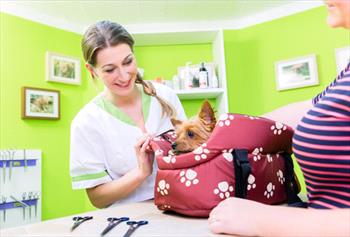Experiencing some fear during veterinary visits is a normal reaction for pets. It’s not fun to be examined by strangers and poked with needles. Pets do not understand why they are there or that the uncomfortable procedures will benefit their health.
Dog Nervous at Vet_179945888

Photo courtesy of Depositphotos
Fear during clinic visits often leads to patient distress, discomfort, and behavior problems. If their fear and anxiety are not addressed effectively, it can worsen over time, become harder to manage safely, and can have negative impacts on their welfare. Fear and emotional distress create challenges that can prevent pets from receiving necessary care. Fear can put people at risk. You may be hesitant to take your pet in just to avoid the experience; some people are embarrassed by their pet’s behavior. Remember they are behaving this way because they are afraid, not because they are bad or trying to embarrass you.
There are several ways to reduce fear and to provide a low-stress experience. Creating that experience is a team effort between you and staff.
Body Language
Reading pet body language appropriately is the key to less stress. Handling can then be adjusted based on what the pet’s body language is saying. If the early signs of stress are ignored your pet’s behavior may escalate. Since animals learn from experience, they may skip the earlier signs entirely at the next visit, intensifying to more aggressive behaviors.
Preparation
You know your pet better than anyone else. Discuss any behavioral concerns when scheduling the appointment so the medical staff will be better prepared for your pet’s visit.
Preparation also includes making transportation comfortable. For example, cats can learn how to be more comfortable entering and riding in their carriers. Carriers with tops that are easily removed are best. Pheromones can sometimes help to reduce anxiety in the car or anti-anxiety medications may be needed. Make sure to wait until your car is at an appropriate temperature before bringing your pet to the car. Calming music, such as classical, can help block out road noise.
Happy Visits
If your dog is fearful, “happy visits” can help them feel more comfortable at the hospital. Stop by for a quick visit that involves positive interaction. Staff can briefly interact, say comforting things, and give your pet treats to improve their perception of the clinic.
What to Look for at the Clinic
- Minimizing time in the waiting room can help reduce stress.
- Some clinics have separate cat and dog waiting and exam rooms. Occupants of cat exam rooms should be out of hearing range from barking dogs. Others may have you wait in your car until an exam room is ready.
- Pheromone diffusers can be used in waiting rooms and exam rooms, and pheromone sprays can be applied to towels before use. Exam rooms and waiting areas should be cleaned and sanitized to prevent disease transmission and reduce stressful scents, such as alarm pheromones or bodily secretions.
- Calming music and limiting noise can help your pet feel more comfortable.
Using Treats at the Clinic
Bring your pet’s favorite treats. While waiting and during the exam, frozen Kong treats or lick mats can help form positive associations with the hospital. Giving treats to a fearful pet will not reinforce fear. If your pet stops eating, then their anxiety and stress level is escalating. This may be the time to stop the exam although some respond to a different type of treat.
In the Exam Room
Examining dogs on the floor and cats in their carrier, on a countertop, or in a lap is usually less stressful. Bring a non-slip mat from home. Many dogs and cats do better if they can stay with you during the exam.
Cats should never be dumped or pulled out of their carrier. Open the door and allow your pet to explore the room on their own. If your pet will not come out within a few minutes, take the carrier apart so they can stay in the bottom. Placing a towel over their body can help them feel more secure.
Cats should not be scruffed during handling. A safer, more compassionate way to handle cats is using towel wraps. Basket muzzles are ideal for dogs if they have been conditioned to wear them comfortably.
Always consider whether the planned procedures need to be completed that day or can wait. If your pet’s stress level is escalating, discontinuation of the exam or procedure may be necessary. If the visit cannot wait ask about taking a break or trying alternative approaches, such as sedation. At the end of this appointment, discuss your pet’s behavior and what could help next time.
Your veterinarian may prescribe anti-anxiety medications for the next visit. Some pets may do better with a mobile veterinarian who provides services in the comfort of your own home. Working with a veterinary behaviorist or a qualified behavior professional may be needed.